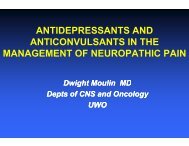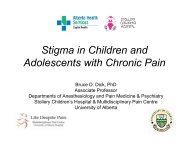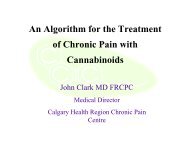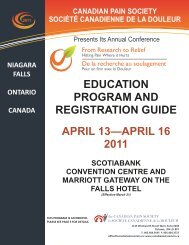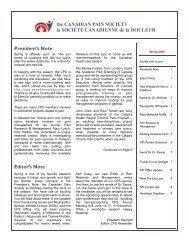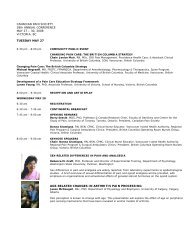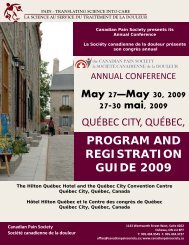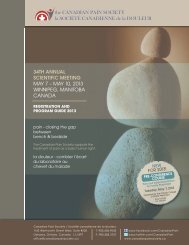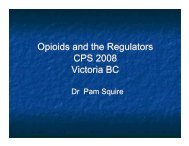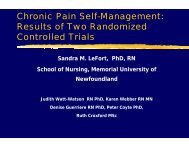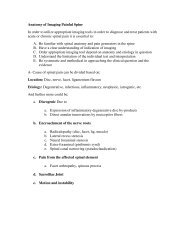Session 304 - Palozzi, Ladak & Schuttenbeld - The Canadian Pain ...
Session 304 - Palozzi, Ladak & Schuttenbeld - The Canadian Pain ...
Session 304 - Palozzi, Ladak & Schuttenbeld - The Canadian Pain ...
- No tags were found...
You also want an ePaper? Increase the reach of your titles
YUMPU automatically turns print PDFs into web optimized ePapers that Google loves.
<strong>Pain</strong> Resource ProgramPresentersLori <strong>Palozzi</strong>, RN, APN, <strong>The</strong> Hospital forSick Children, ONSalima <strong>Ladak</strong>, RN, APN, Toronto GeneralHospital, ONNancy <strong>Schuttenbeld</strong>, RN, APN, RiverValley Health, NB
Objectives of Workshop To review the literature on the <strong>Pain</strong>Resource Nurse (PRN) role To discuss the development of the <strong>Pain</strong>Resource Role at Sick Kids To explore key components of <strong>Pain</strong>Resource Programs
Objectives of Workshop To discuss factors influencingimplementation To discuss program evaluation To explore variables affectingsustainability Your challenge….complete atemplate for a PRP.
Literature Review
Definition “Resource and role model for nursingassessment and intervention in painmanagement” (Ferrell et al 1993) “Act as resources, coaches, mentors,role models and champions forimproved pain management”(McLeary et al 2004)
Knowledge Translation and <strong>Pain</strong> Gap in pain practice not relatedto knowledge generation butperhaps related to knowledgetranslation Can a PRP or PRN facilitateknowledge transfer?
Role Development First PRN program; Ferrell 1993,Oncology setting, 40 hr didactic andclinical application McLeary et al, pediatric setting 2004,2 day session Holly et al, 32 hours, Veteranshospital D’arcy– 6 hours
PRN Strategies Communication about pain with MDs Staff education, unit rounds Monthly support meeting <strong>Pain</strong> research and QI projects at unit level visible and accessible Monitor and evaluate practice- givefeedback Coach, role model, advocate, troubleshoot
Impact of PRN role in K & A score at 3 mo includingattitude toward pt with pain, but no diff in# of pts with pain (Ferrell, 1993) RNs report increased confidence (D’Arcy,2004) Improvement in severity of opioid-inducedinducedconstipation, pain asst, documentation ofpain sites and side effects (McMillan,2005)
Role Development:SickKids Experience
Development of a PRN role PARIHS framework- evidence,context and facilitation Purpose:• To describe the PRN from theperspectives of nurses and non-nursenursehealth professionals• To identify benefits and barriers to thePRN role
Research Questions• What are the qualities and essentialcomponents of the PRN role from theperspectives of the individual nurse,unit and organization?• What are the views of the individualnurse, unit and organization on thepotential benefits and barriers ofimplementing a PRN role on a generalhospital unit?
Methods• Sample – staff nurses, advancedpractice nurses, educators, physicians,acute and chronic pain team• Setting- 2 inpatient surgical units• Focus groups using semi-structuredstructuredinterviews, APN facilitators
Key Components of<strong>Pain</strong>Resource Programs
Key ComponentsReviewing theRiver Valley Health experiencein New Brunswick<strong>The</strong> Model for ImprovementWhat are we tryingto accomplish?How will we know achange is an improvement ?What change can we makethat will result in improvement?AimMeasuresChangeActStudyPlanDoCYCLES forTesting & ImplementingChangeLangley, Nolan, Nolan, Norman, Provost;Improvement Guide, 1996
Quality Improvement Cycle: PDSAACTMakeDecisionSTUDYAct ondecisionsEvaluateImpactSelectprojectImplementchangeEstablishcurrentknowledgePlan DataCollectionPLANDevelopActionPlanDOCQI Network
Key Components Program Planning Selecting Content Program Implementation Evaluation
Key ComponentsProgram Planning: Establish need Support for project Identify key stakeholders
Key ComponentsProgram Planning: Determine # of participants Consider qualities Develop criteria Obtain commitment from Managers
Key ComponentsSelecting ContentInclude assessment & F/U,Explore misconceptions,Monitoring,Pharmacology,Case studiesReflective exercises
Key Components Keep it interactive! Team building Address gaps in practice Utilize resources Address needs ofparticipants
Key ComponentsMultidisciplinary or Nurses only? Explore needs of organization Explore pros and cons
ProgramImplementation
Factors Affecting Implementation Strength of facilitators Program objectives Consideration of contextualfactors in work environment
Implementation IssuesFacilitators Expert nurses, committed, compassionate Monthly meetings Networking/support from other PRN’s Buy in from managers, MDs High satisfaction with role Increased awareness of patient centeredcare Unit support/ support from pain APN
Implementation IssuesBarriersProblems with co-workersTimeIntegrating the PRN rolewithin the nursing roleSelf-doubtResistance to PRN expertiseLack of role clarify
Program Evaluation
Program Evaluation Program content <strong>Pain</strong> resource role Impact of program on patients,nurses, units, organization
Evaluating Outcomes…Include Quantitative AND QualitativemeasuresExamples:Pre and post K&A for participants Patient Questionnaires in departments,facilities Focus groups, sharing stories “<strong>Pain</strong> Report Card”
Evaluation of PRN Program atUHN Improving <strong>Pain</strong> ManagementThrough Capacity Building:Experience of the <strong>Pain</strong> ResourceNurse (PRN) Role ImplementationSalima S. J. <strong>Ladak</strong>, RN, MN-APN
Quality improvement initiative inresponse to patient pain satisfactionscores Goal: Improve pain managementpractices at UHN Select group of RNs received 4-day 4educational program in addition totime with APN Mentor in <strong>Pain</strong>Management
Focus Group Study Outline Approved by Research Ethics Board Funded by Krembil FoundationGuiding Research Question:How did implementation of the PRN role atUHN work?
Use of Roy’s s adaptation model as framework(PRN role function as adaptation to a change inthe professional nursing role)Qualitative descriptive study using open endedfocus group questionsConvenience samplingInterview tape recorded and transcribed by RA
Participant Demographics (N = 21) 90% Female; 10% male Years worked at UHN = 12.3 Years in Nursing profession = 17.2 Employment status:• Part time 2 PRNs (9%)• Full time 19 PRNs (91%)
Education:• Diploma – 8 (38%)• Bachelor’s s Degree – 9 (43%)• No response - 4 Previous Leadership Positions:• 3 PRNs – No• 18 PRNs – Yes• Eg: : Unit Council, Charge RN, Care Leader
Objectives:Focus Group Analysis Describe role expectations of the pain resourcenurses at UHN. Describe what contributes to role clarity for PRNsat UHN. Describe role conflict with the PRN role at UHN. Describe future role expectations and roledevelopment needs of PRNs at UHN.
Describe role expectations of the painresource nurses at UHN Function as a resource in a leadership role forstaff and further pain management knowledge Patient advocacy Resource for clinical decision making
Describe what contributes to Role Clarity forPRNs at UHN Leadership support on unit Support from <strong>Pain</strong> Management AdvancePractice Nurse
Describe role conflict with the PRN role atUHN Confusion about scope of practice Lack of awareness of the PRN role Lack of time, human resources
Describe future role expectations and roledevelopment needs of PRNs at UHN Additional time More educational opportunities Increased human resources capacity Improved Role Awareness
Impact on Patient Satisfaction Increased satisfaction from 87.6 to88.9% (statistically significant atp=0.001.Data Source: NRC Picker Patient Satisfaction, UHN Total July 2003-March2004 (N=4,075) April 2004-August 2006 (N=13,085)Score: Yes, definitely = 100, Yes, somewhat = 50, No = 0; UHNMethodology
Limitations No statistical analysis of responses Ability of participants to voiceopinions freely
Sustainability
Sustainability Being real and setting realisticexpectations.
Sustainability Strategies Contract with participants Provide bimonthly feedback F/U 1 page evaluation for participants Focus groups if possible Reconnect via intranet and shareprojects Highlight projects at annual <strong>Pain</strong>Conference
Take Home Messages <strong>The</strong> PRP is an effective strategy increating organizational change toimprove the management of pain. <strong>The</strong> PRP provides an opportunity tofacilitate knowledge transfer T/Ohealthcare organizations.
Take Home Messages When implementing a PRP, setattainable goals, & have fun!
Questions?lori.palozzi@sickkids.canancy.schuttenbeld@rvh.nb.casalima.ladak@uhn.on.ca





